| Author: | |
| Website: | |
| Page title: | |
| URL: | |
| Published: | |
| Last revised: | |
| Accessed: |
| Year: | 1978 |
| Original platform: | DEC PDP-10 mainframe |
| Brief description: | Text-based multiplayer real-time virtual world |
| Number of players: | Multiplayer |
| Developers/contributors: | Roy Trubshaw, Richard Bartle |
The term MUD (Multi-User Dungeon) can actually be applied to an entire category of (mostly) text-based role playing games (RPGs) that have emerged over the last few decades. The game we are primarily interested in here is sometimes referred to as MUD1, or Essex MUD, and is considered by many protagonists to be the original, and perhaps the best, multi-user dungeon. The origins of MUD actually go back somewhat further.
Stop playing the opening music for Star Wars! We're not talking about a long time ago in a galaxy far, far away. If we have to choose a place to start, the story probably begins with a single-player adventure game created by programmer and cave explorer William Crowther in 1976 called Colossal Cave Adventure. Crowther was apparently inspired by the Dungeons and Dragons fantasy role-playing game. Crowther based the game's environment on the real-world Mammoth Cave system in Kentucky, USA, which he had personally explored extensively.
At the time, Crowther worked as a programmer for Bolt, Beranek & Newman, a US high-tech company that had a major role in developing ARPANET, the forerunner of the Internet. The original game was written in the Fortran programming language, and ran on a Digital Equipment Corporation PDP-10 mainframe computer. The game was eventually ported to various other platforms, and a number of different versions of the game emerged.
In 1976 programmer Don Woods, who had come across Crowther's original version of the game by accident, e-mailed Crowther asking for permission to develop the game further. Crowther gave his blessing, and by the following year copies of Woods' enhanced version of the game were being distributed via the Internet. The game apparently inspired Ken and Roberta Williams to start their own gaming software company, On-Line Software. The company prospered, and later went on (as Sierra Entertainment) to produce a number of commercially successful adventure games, including King's Quest and Leisure Suit Larry.
It is probably the 1977 Crowther/Woods version of the game that is most often considered to be the definitive classic version, although various other versions have been written, including several written by Don Woods himself. It is quite difficult to describe a game of this nature to someone who has never played it.
Perhaps the best way to find out what it's all about is to play it for yourself. Several versions can be downloaded as DOS executables here. The versions we have tried will not run directly under a 64-bit version of Windows, but will run quite happily in DOSBox. The following series of screenshots are taken from Kevin Black's DOS version of the original game, as written by William Crowther and extended by Don Woods.
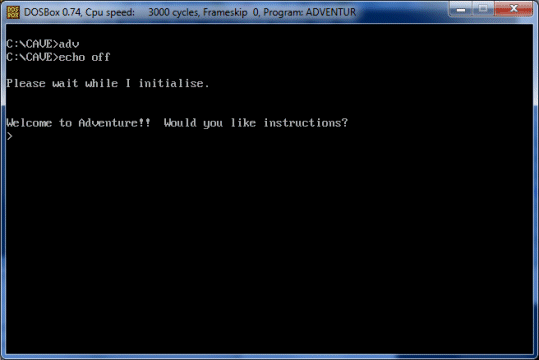
On startup, the game offers you some instructions
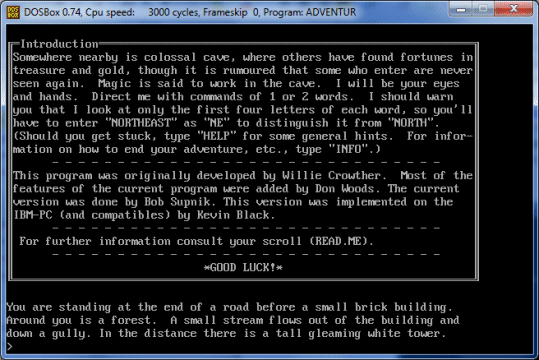
We needed all the help we could get!
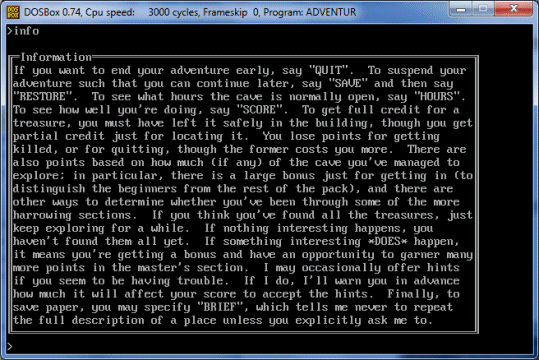
The contents of the INFO screen
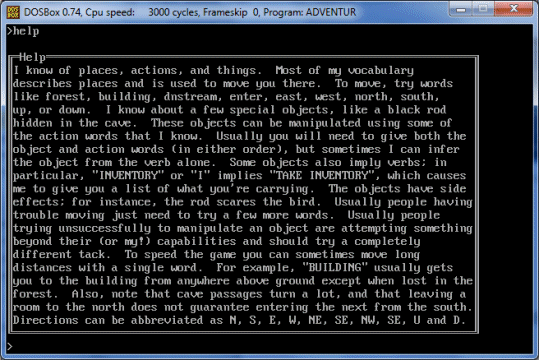
The contents of the Help screen
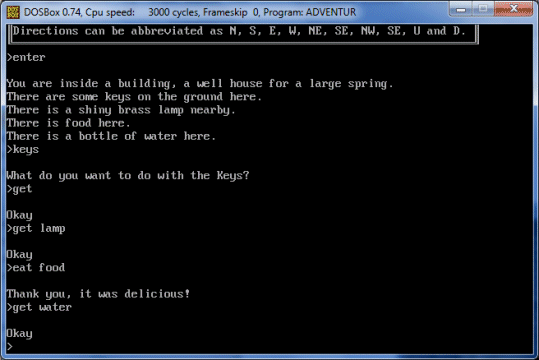
The adventure begins . . .
You probably get the general idea from the above screen shots as to how the game proceeds. The player enters short one- or two-word commands, and the game responds with some helpful (or sometimes not so helpful) text. Woods was an admirer of the work of J.R.R. Tolkien (the author of "The Hobbit" and "Lord of the Rings"), so expect to come across fantasy elements such as axe-wielding dwarves, magic bridges, elves, trolls, and so-on.
A number of "magic" words and phrases also exist within the game's vocabulary that will (for example) instantly transport you from one location to another if used at certain points in the game. In some cases, the action triggered by a vocabulary word or phrase will be randomly generated. The idea, generally, is to navigate your way through the game, collecting treasures and earning points while avoiding getting killed. Treasures can be used at different locations within the game for various purposes.
In 1977, a small group of students at the Massachusetts Institute of Technology (MIT) produced their own single-player adventure game, apparently inspired by Colossal Cave Adventure, called Zork. The program was written using the MIT Design Language (MDL), which was closely related to LISP, a language commonly used for artificial intelligence programs. Like Colossal Cave Adventure, Zork ran on a DEC PDP-10 mainframe computer.
Some of the game's creators went on to form the Massachusetts-based software company Infocom, which would produce a trilogy of Zork games that ran on all popular personal computers of the time, including the Commodore 64 and the Apple II. The games were released in 1980 (Zork I: The Great Underground Adventure), 1981 (Zork II: The Wizard of Frobozz), and 1982 (Zork III: The Dungeon Master). You can download playable versions of all three games on the Infocom website here.
The MIT version of Zork, which could be downloaded via the ARPANET, was the inspiration for the original MUD. In 1978, a student at Essex University called Roy Trubshaw started programming the first version of MUD on a DEC PDP-10 Mainframe computer installed at the university. The program was originally written in the MACRO-10 assembly language, although some time prior to 1980 Trubshaw re-wrote the code in the Basic Combined Programming Language (BCPL) in order to make it easier to maintain (BCPL was a forerunner of C).
Trubshaw was an avid fan of Zork, and derived the name MUD (which as mentioned previously stands for Multi-User Dungeon) from the name of an early Zork variant called Dungeon. Like the single-player games that preceded it, MUD is a text-based role-playing adventure game in which the player finds themselves in a fantasy world though which they must navigate using brief commands consisting of words or phrases. Unlike its predecessors, however, MUD allowed a number of players to participate in the game simultaneously and to interact with one another.
One of Trubshaw's design goals for the game was to create a database that would allow changes or additions to be made without having to re-compile the program code. In this task he was ably assisted by fellow student Richard Bartle. When Trubshaw graduated late in 1980, he left the further development and management of MUD in the hands of Bartle. That same year saw developments that enabled MUD to reach a wider audience.
Until 1980, the number of players was limited by the number of network connections available. The number of players who could potentially access the game increased dramatically when the university's network was connected to the ARPANET in 1980. The number increased again in 1983, when a guest account was set up to allow users of the UK's Joint Academic Network (JANET) to access the game. MUD had become the first multiplayer online role-playing adventure game. Access to the game was free at weekends, and between 0200 hours and 0800 hours GMT during the week.
Although access to MUD on Essex University's network was free of charge during the designated hours, it was also limited by the number of available connections, and was consequently over-subscribed. In 1984, MUD was licensed by Compunet, a UK-based network that catered primarily to Commodore 64 users. Compunet ran the game on their PDP-10 mainframe computer, providing access to the game for its users on a commercial basis. The service was discontinued when the PDP-10 was decommissioned in 1987.
By 1985, Bartle had developed the version of MUD that was to become known as MUD2. This version was licensed by Compuserve, a US-based Internet service provider, who also provided access to the game (under the name British Legends) on a commercial basis. In 1987, allegedly as a result of pressure from Compuserve, Bartle closed down the instance of MUD running on Essex University's network. Compuserve closed their own version of the game down in 1999, allegedly as part of a broader Y2K cleanup process.
Essex MUD (or MUD1) has spawned many variants and imitators, one of the most popular of which was a variant of the original MUD called MIST. Once Essex MUD was closed down in 1987, MIST was the only MUD variant still available on the university's network. MIST survived for a further four years by virtue of the fact that it ran from a separate account to MUD1, although it too met its demise when the PDP-10 mainframe that hosted it was replaced in 1991.
MUD's legacy can be seen today in many different forms. Thanks to an exponential increase in processing power and the widespread availability of high-speed internet access, a number of graphical multiplayer online role-playing adventure games have emerged. Such games were initially called simply graphical MUDs, but in the late 1990s the term Massively Multiplayer Online Role-Playing Games (MMORPGs) became the preferred term. Undoubtedly the best-known example is World of Warcraft. Gaming connoisseurs interested in playing MUD1 should check out Viktor Toth's British-Legends website here.
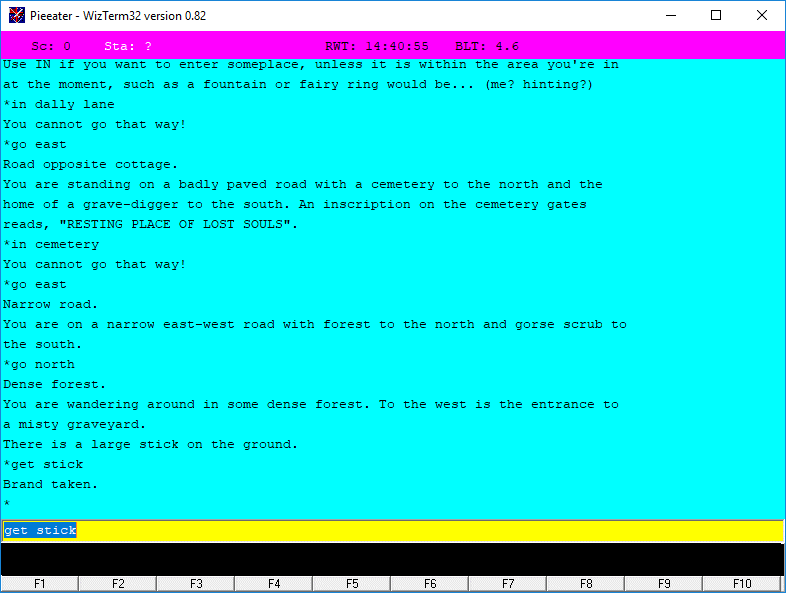
A screenshot from MUD1 (WizTerm version) as implemented on www.british-legends.com